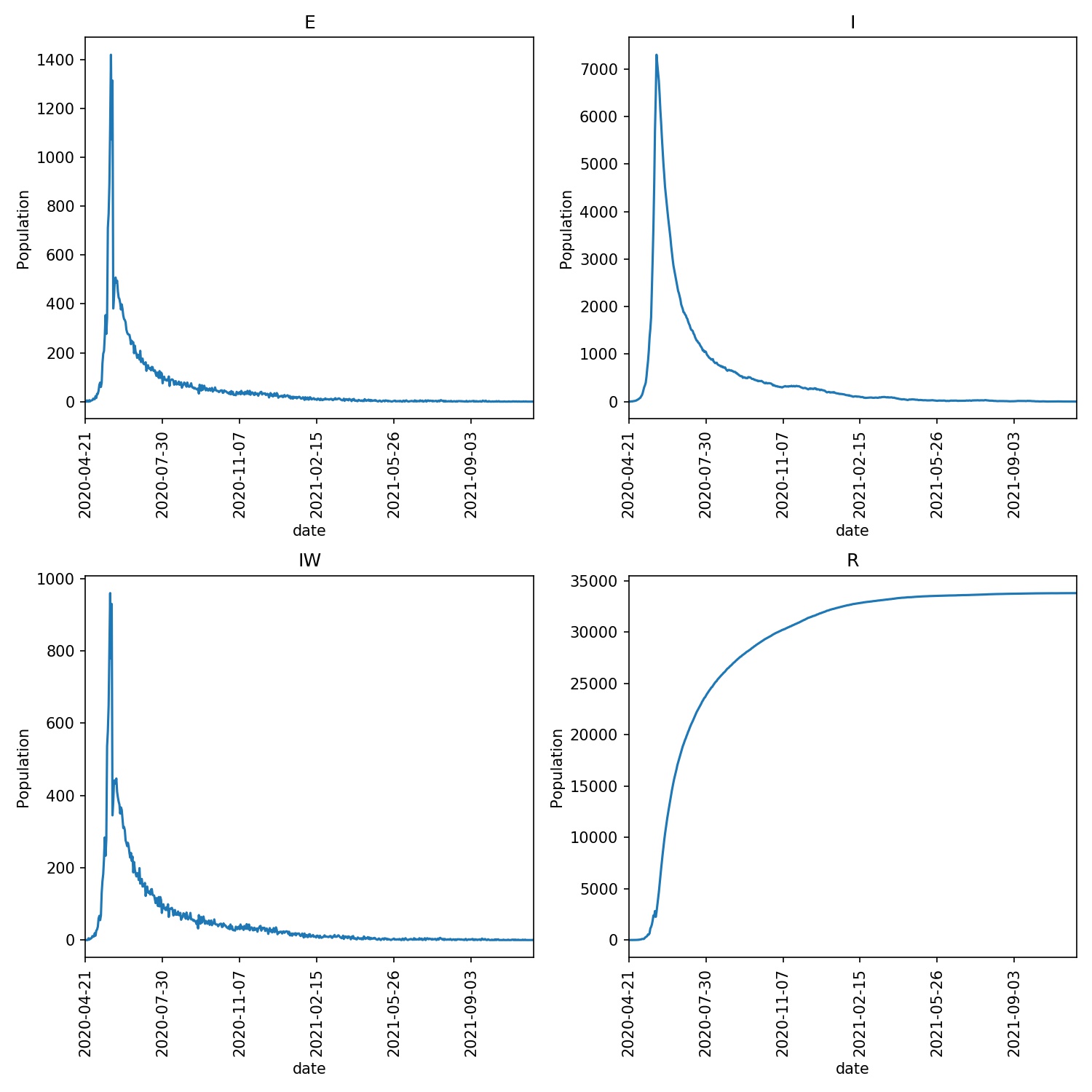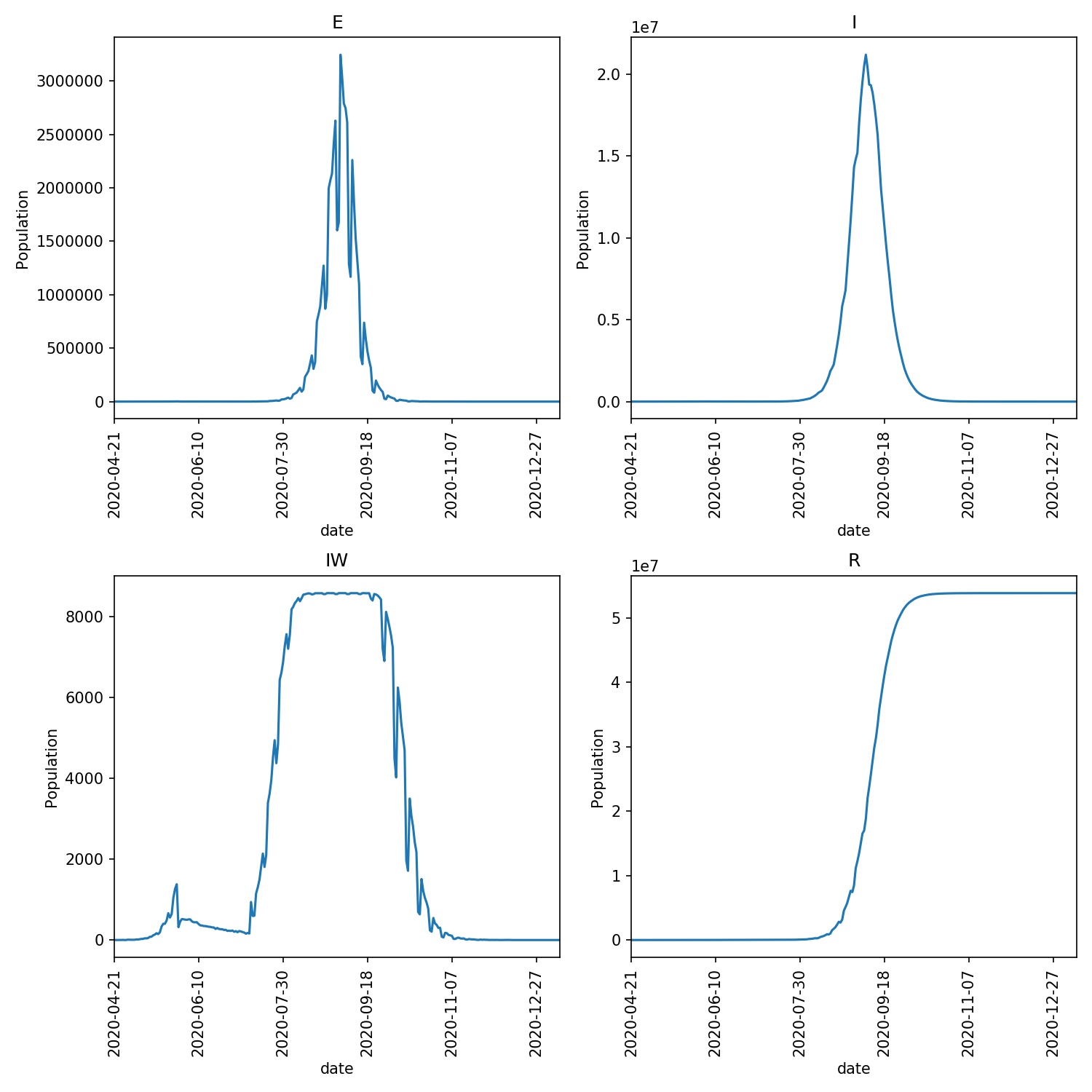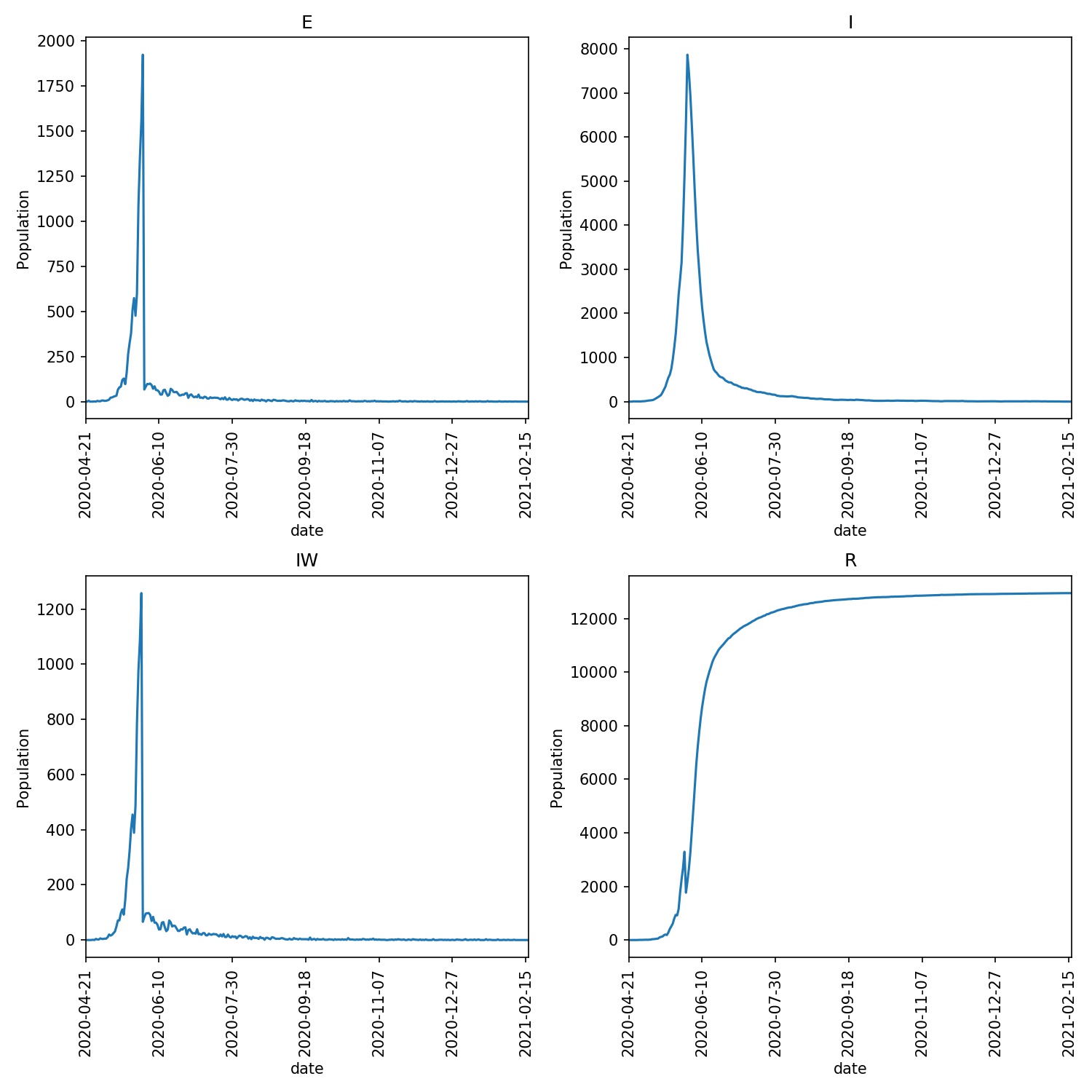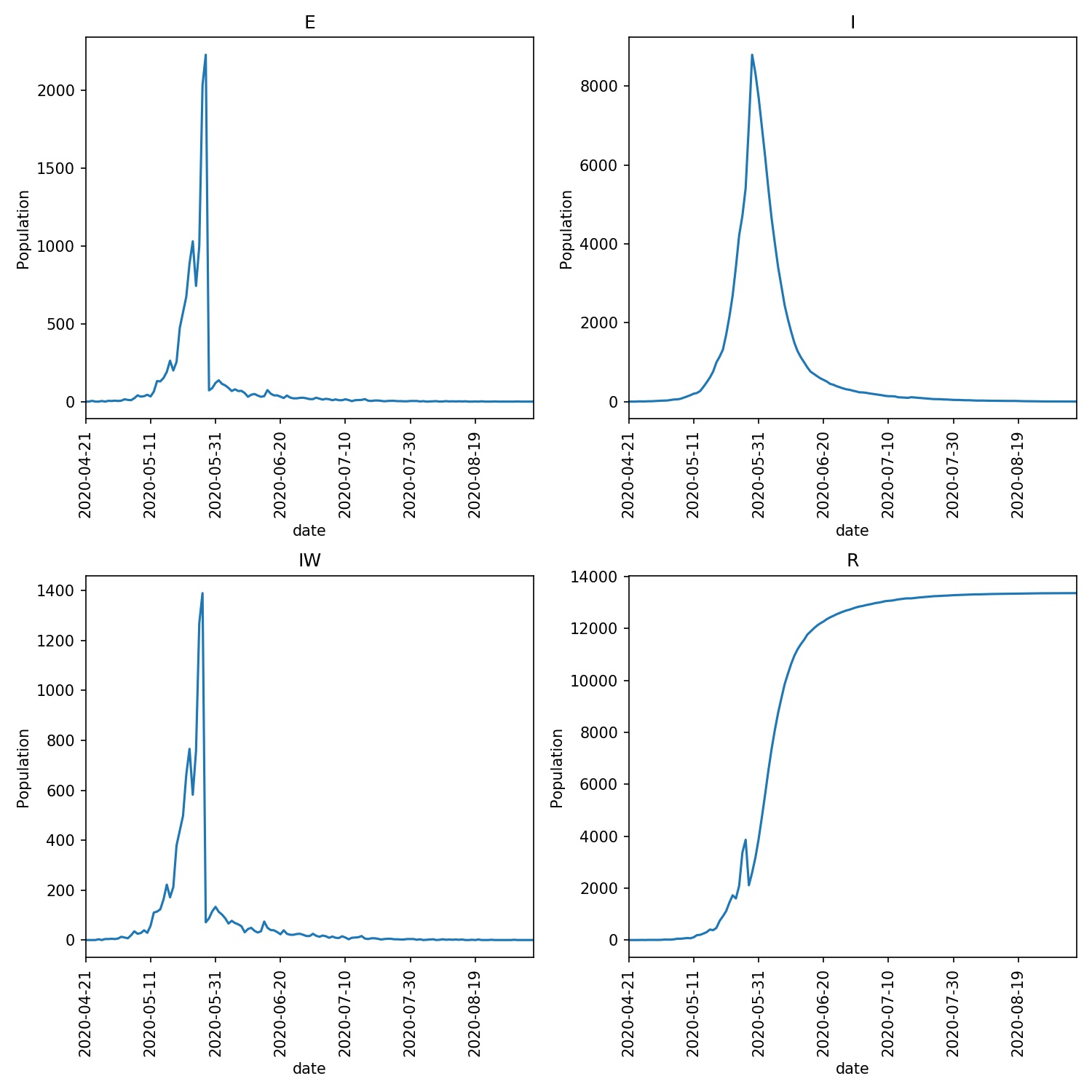Responding to changing conditions¶
We’ve now created a lock-down advance function, but are currently triggering this function in an iterator based on a fixed number of days since the outbreak started.
A better approach would be to trigger the lock-down based on the number of individuals who are detected as infected in the model.
To do this, edit your lockdown.py script and copy in the following;
from metawards.iterators import iterate_working_week, \
advance_infprob, \
advance_fixed, \
advance_play
def advance_lockdown(**kwargs):
print("We are on lockdown")
advance_infprob(scale_rate=0.25, **kwargs)
advance_play(**kwargs)
def iterate_lockdown(population, **kwargs):
if not hasattr(population, "lockdown_state"):
population.lockdown_state = "before"
population.is_locked_down = False
if population.lockdown_state == "before":
if population.total > 5000:
population.lockdown_state = "lockdown"
population.lockdown_started = population.day
population.is_locked_down = True
if population.is_locked_down:
return [advance_lockdown]
else:
return iterate_working_week(population=population,
**kwargs)
The first thing we do here is see if the population has a
lockdown_state variable using the standard Python
hasattr function.
This variable won’t exist on the first call to
to iterate_lockdown, and so here we
set the lockdown_state to before
and set the flag population.is_locked_down to False.
Next, we check if the lockdown is in the before state. If it is,
then if the total infected population is greater than 5000 we change
the lockdown_state to lockdown, save the day the lockdown
started to population.lockdown_started, and set the flag
population.is_locked_down to True.
Finally, we either return our advance_lockdown advance function,
or the standard advance functions for a working week depending
on the value of the population.is_locked_down flag.
Run the model and draw the overview graph using;
metawards -d lurgy3 --additional ExtraSeedsLondon.dat --iterator lockdown
metawards-plot -i output/results.csv.bz2 --format jpg --dpi 150
You should now see that the lockdown takes effect some time after the infected population grows above 5000. This tips the curve and reduces the spread of the disease. You can see what my graphs looked like here;

Releasing lockdown¶
We can use the data in population to decide when to release the
lockdown as well. For example, we could release when the size of the
infected population drops below 2000. To do this, edit your lockdown.py
file to read;
from metawards.iterators import iterate_working_week, \
advance_infprob, \
advance_fixed, \
advance_play
def advance_lockdown(**kwargs):
print("We are on lockdown")
advance_infprob(scale_rate=0.25, **kwargs)
advance_play(**kwargs)
def iterate_lockdown(population, **kwargs):
if not hasattr(population, "lockdown_state"):
population.lockdown_state = "before"
population.is_locked_down = False
if population.lockdown_state == "before":
if population.total > 5000:
population.lockdown_state = "lockdown"
population.lockdown_started = population.day
population.is_locked_down = True
elif population.lockdown_state == "lockdown":
if population.total < 2000:
population.lockdown_state = "after"
population.lockdown_ended = population.day
population.is_locked_down = False
if population.is_locked_down:
return [advance_lockdown]
else:
return iterate_working_week(population=population,
**kwargs)
Run the model as before and see what happens…
To start, the lockdown has worked and the number of infections has fallen, with the number falling below 2000 on day 78. However, releasing the lockdown completely leads to a rapid growth in the infection, with over 85,000 infected three weeks after lockdown ended. This is unsurprising, as there was still a lot of infected individuals remaining once lockdown ended, and a large population that was still susceptible to infection (as you can see from the print of my run and the overview graph below).
S: 56057097 E: 213 I: 2189 R: 22578 IW: 197 TOTAL POPULATION 56081864
We are on lockdown
76 2402
S: 56056905 E: 200 I: 2133 R: 22839 IW: 184 TOTAL POPULATION 56081877
We are on lockdown
77 2333
S: 56056746 E: 192 I: 2101 R: 23038 IW: 157 TOTAL POPULATION 56081885
We are on lockdown
78 2293
S: 56056568 E: 159 I: 2061 R: 23289 IW: 176 TOTAL POPULATION 56081918
We are on lockdown
79 2220
S: 56056399 E: 178 I: 1983 R: 23517 IW: 162 TOTAL POPULATION 56081899
80 2161
S: 56055290 E: 169 I: 1904 R: 24714 IW: 942 TOTAL POPULATION 56081908
81 2073
S: 56054625 E: 1109 I: 1853 R: 24490 IW: 596 TOTAL POPULATION 56080968
82 2962
S: 56053957 E: 665 I: 2728 R: 24727 IW: 602 TOTAL POPULATION 56081412
83 3393
S: 56052602 E: 668 I: 3162 R: 25645 IW: 1151 TOTAL POPULATION 56081409
84 3830
S: 56051035 E: 1355 I: 3601 R: 26086 IW: 1304 TOTAL POPULATION 56080722
85 4956
S: 56049197 E: 1567 I: 4689 R: 26624 IW: 1492 TOTAL POPULATION 56080510
86 6256
S: 56046897 E: 1838 I: 5977 R: 27365 IW: 1811 TOTAL POPULATION 56080239
87 7815
S: 56044064 E: 2300 I: 7445 R: 28268 IW: 2140 TOTAL POPULATION 56079777
88 9745
S: 56041777 E: 2833 I: 9318 R: 28149 IW: 1808 TOTAL POPULATION 56079244
89 12151
S: 56039009 E: 2287 I: 11558 R: 29223 IW: 2106 TOTAL POPULATION 56079790
90 13845
S: 56033706 E: 2768 I: 13086 R: 32517 IW: 3391 TOTAL POPULATION 56079309
91 15854
S: 56027735 E: 5303 I: 14968 R: 34071 IW: 3622 TOTAL POPULATION 56076774
92 20271
S: 56020915 E: 5971 I: 19179 R: 36012 IW: 3947 TOTAL POPULATION 56076106
93 25150
S: 56012334 E: 6820 I: 23835 R: 39088 IW: 4518 TOTAL POPULATION 56075257
94 30655
S: 56001786 E: 8581 I: 29059 R: 42651 IW: 4947 TOTAL POPULATION 56073496
95 37640
S: 55994025 E: 10548 I: 35825 R: 41679 IW: 4377 TOTAL POPULATION 56071529
96 46373
S: 55984596 E: 7761 I: 44092 R: 45628 IW: 4847 TOTAL POPULATION 56074316
97 51853
S: 55965009 E: 9429 I: 49023 R: 58616 IW: 6443 TOTAL POPULATION 56072648
98 58452
S: 55943662 E: 19587 I: 55002 R: 63826 IW: 6618 TOTAL POPULATION 56062490
99 74589
S: 55919882 E: 21347 I: 70325 R: 70523 IW: 6883 TOTAL POPULATION 56060730
100 91672
S: 55889466 E: 23780 I: 86623 R: 82208 IW: 7276 TOTAL POPULATION 56058297

Note how the second wave of infection makes the initial wave almost invisible in this graph. The only visible evidence is the small peak in the number of infected wards (IW) plot.
Relaxing, not removing lockdown¶
The problem is that we treated lockdown like a binary switch, and immediately went back to normal once it was lifted.
Instead, we need to release the lockdown in stages. To model this,
edit your lockdown.py to contain the following.
from metawards.iterators import iterate_working_week, \
advance_infprob, \
advance_fixed, \
advance_play
def advance_lockdown(population, **kwargs):
print(f"We are on lockdown ({population.lockdown_scale_rate})")
advance_infprob(scale_rate=population.lockdown_scale_rate,
**kwargs)
advance_play(population=population, **kwargs)
def iterate_lockdown(population, **kwargs):
try:
population.lockdown_state
except Exception:
population.lockdown_state = "before"
population.is_locked_down = False
population.lockdown_scale_rate = 0.05
if population.lockdown_state == "before":
if population.total > 5000:
population.lockdown_state = "lockdown"
population.lockdown_started = population.day
population.is_locked_down = True
elif population.lockdown_state == "lockdown":
if population.total < 2000:
population.lockdown_state = "relaxed_lockdown"
population.lockdown_ended = population.day
population.lockdown_scale_rate = 0.10
population.is_locked_down = True
elif population.lockdown_state == "relaxed_lockdown":
if population.total < 1000:
population.lockdown_scale_rate = 0.20
else:
population.lockdown_scale_rate = 0.10
if population.is_locked_down:
return [advance_lockdown]
else:
return iterate_working_week(population=population,
**kwargs)
In this code we have created a new lockdown state that we’ve called
relaxed_lockdown. This is entered when the number of infections
drops below 2000. In this state controls can be released that
correspond to now only halving the infection rate (scale_rate
is increased to 0.10 from 0.05 during the strong lockdown).
In the relaxed_lockdown state the infected population
is always checked. If it is below 1000 then the lockdown can be
relaxed even more, with the scale_rate increasing from 0.10
to 0.20. However, if the infected population rises above 1000,
then the lockdown is tightened and the scale_rate is lowered
again to 0.10.
Have a go at running using this iterator. What do you see? In my
case I see the model moving from lockdown (scale_factor==0.05),
through relaxed lockdown (scale_factor==0.1) to light
lockdown (scale_factor==0.2) during the outbreak, which
is brought under control. The overview plots are here;

There is a small second peak as the lockdown is relaxed, but this seems to be under control.
Warning
Remember, we cannot read too much into single model runs as these are very stochastic simulations. We would need to run models many times and average before we could gain real insight.
Returning to work¶
Because Python is dynamically typed, we can set whatever flags
or add whatever data we want to the population object that
we need (or indeed to any Python object).
Let’s now add an extra flag that will be used by
advance_lockdown to call advance_fixed if the lockdown
has been lifted sufficiently for people to return to work.
Copy the below into your lockdown.py file;
from metawards.iterators import iterate_working_week, \
advance_infprob, \
advance_fixed, \
advance_play
def advance_lockdown(population, **kwargs):
print(f"We are on lockdown ({population.lockdown_scale_rate})")
print(f"is_work_locked_down == {population.is_work_locked_down}")
advance_infprob(scale_rate=population.lockdown_scale_rate,
**kwargs)
advance_play(population=population, **kwargs)
if not population.is_work_locked_down:
advance_fixed(population=population, **kwargs)
def iterate_lockdown(population, **kwargs):
if not hasattr(population, "lockdown_state"):
population.lockdown_state = "before"
population.is_locked_down = False
if population.lockdown_state == "before":
if population.total > 5000:
population.lockdown_state = "lockdown"
population.lockdown_started = population.day
population.is_locked_down = True
population.lockdown_scale_rate = 0.05
population.is_work_locked_down = True
elif population.lockdown_state == "lockdown":
if population.total < 2000:
population.lockdown_state = "relaxed_lockdown"
population.lockdown_ended = population.day
population.lockdown_scale_rate = 0.05
population.is_locked_down = True
population.is_work_locked_down = False
elif population.lockdown_state == "relaxed_lockdown":
population.is_work_locked_down = False
if population.total > 5000:
population.lockdown_state = "lockdown"
population.lockdown_started = population.day
population.is_locked_down = True
population.lockdown_scale_rate = 0.05
population.is_work_locked_down = True
elif population.total < 1000:
population.lockdown_scale_rate = 0.1
else:
population.lockdown_scale_rate = 0.05
if population.is_locked_down:
return [advance_lockdown]
else:
return iterate_working_week(population=population,
**kwargs)
This is getting longer, but I hope you can see that all we have
added is a population.is_work_locked_down flag, plus some
extra code to flip this between True and False. This flag
is read by advance_lockdown, which calls advance_fixed
if the flag is False. We’ve also added a check to see if the
infected population rises above 5000 while in “relaxed lockdown”,
and if it does, to re-enter full lockdown.
Run the model and plot the graphs. What do you see? Do you get a graph similar to below?
